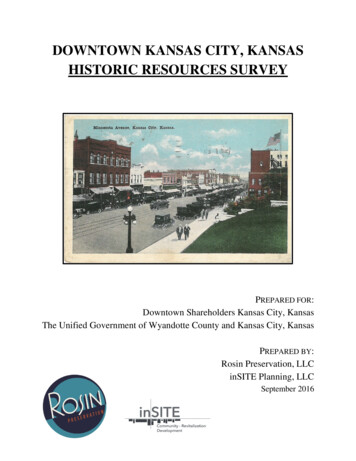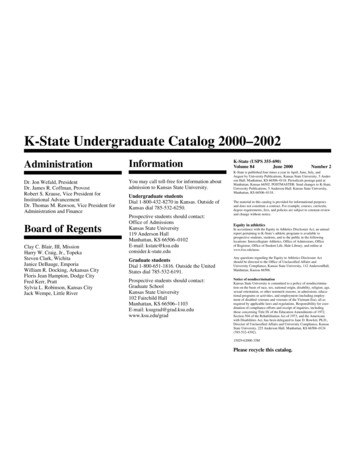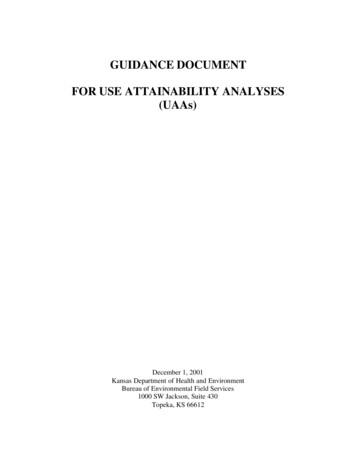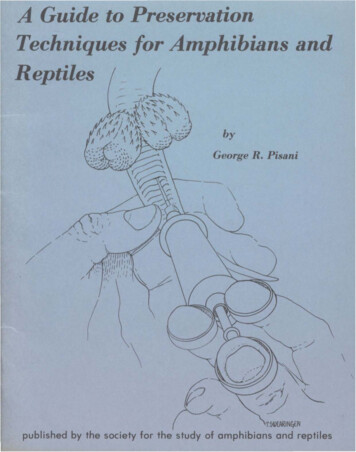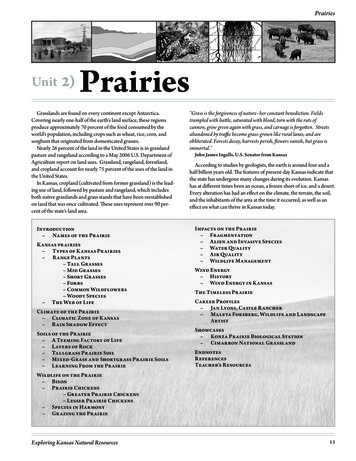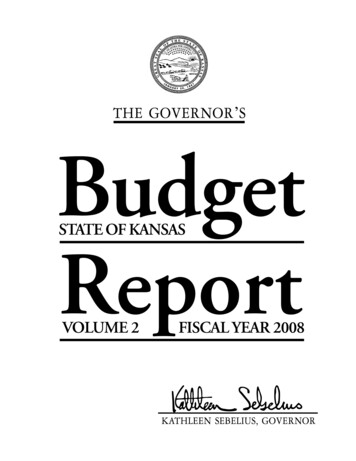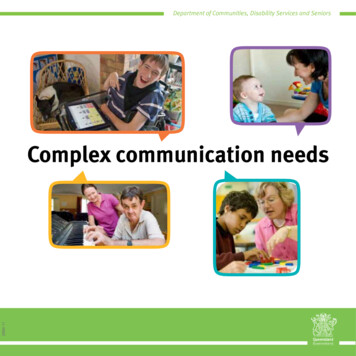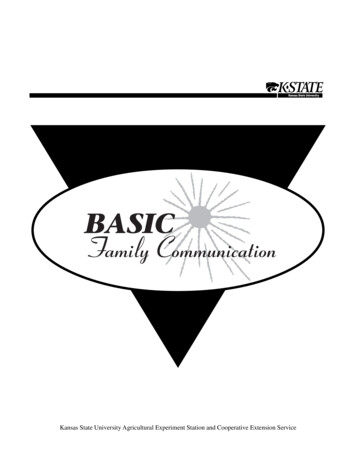
Transcription
Kansas State University Agricultural Experiment Station and Cooperative Extension Service
Table of ContentsLeader’s Guide Overview . 1Warm Up . 4Activities 1-5 . 5-13Evaluations .16Why Family Communication is Important Fact Sheet .27Take Time to Listen Fact Sheet . 29How We Say it Makes a Difference Fact Sheet . 32The Impact of Unspoken Rules Fact Sheet . 34Handling Tough Times Fact Sheet . 36Having Fun Fact Sheet . 391 Kansas State University Agricultural Experiment Station and Cooperative Extension Service
Leader’s GuideOVERVIEWBasic Family Communication is designed for families who are seeking toimprove everyday communication among family members. This educationalprogram emphasizes skill-building for improving family communication andinteraction. It is NOT a replacement for families who need counseling ortherapy to deal with their family problems.The goal of the program is to nurture in family members the capacity toengage in mindful communication with each other. Mindfulness refers tobeing fully present when communicating with each other and makingcommunication decisions that take into consideration the needs andcircumstances of self and others (Smith, 1999).OBJECTIVESParticipants will learn: How family communication affects family relations. Effective ways to listen to other family members. Respectful ways to express themselves. The impact of unspoken family rules. How to handle difficult issues. The benefits of having fun together.PROGRAM DESIGNThe following six basic concepts are used to describe family communication: Why Family Communication Is Important Take Time to Listen How We Say It Makes a Big Difference The Impact of Unspoken Rules Handling Tough Times Having Fun Together1 Kansas State University Agricultural Experiment Station and Cooperative Extension Service
Leader’s GuideOverviewEach communication concept, available on separate master, can be copied forpersons inquiring about a specific issue. These fact sheets give a briefexplanation of the concept followed by examples and skill building ideas forimproving family communication.When planning a family communication workshop, this leader guide gives asuggested format for a two-hour session that provides an overview of all theinformation. If you have less time to conduct the workshop or want to focuson particular concepts most suited to a given audience, decide which groupactivities can be deleted. You may also wish to have a series of workshops,using one activity per session.ROLE OF THE GROUP LEADEREffective leaders will approach this workshop both as a teacher and a learner.Smith (1999) indicates that a teacher provides quality information, but alsolearns from the participants. The teacher continually asks: What do theparticipants know? How have they used this knowledge? What other conceptsare they identifying?Smith (1999) in Basic Parenting also talks about process versus content:“Program resources provide content. However, the process — the discussionthat occurs, the listening and encouragement, responding to questions,laughing and taking chances — is import ant, too. How the session is organizedand how it evolves is an extremely important part of the educational experience.A content-rich program that is lifeless and rigid will not be very successful(p. 19).”TARGET AUDIENCEThe program resources are written for adults and older adolescent youth. Thesize of a workshop group should be between 6 and 18 participants. A smallergroup can evolve into a counseling-type session, which might lead todifficult situations for the group leader. This information is intended to bepresented in an educational format only. Having a group with more than 18participants has a tendency to limit group discussion opportunities.2 Kansas State University Agricultural Experiment Station and Cooperative Extension Service
Leader’s GuideOverviewBEFORE STARTINGThis workshop will go smoother if you: Carefully review this leader’s guide and each of the fact sheets. Decide which of the activities and fact sheets you will use. Prepare yourself for each activity by mentally thinking about participantreactions and your responses. Make copies of the selected fact sheets and evaluation forms for eachparticipant. Assemble supplies, if needed.WORKSHOP PRESENTATIONThe workshop format is built upon the Experiential Learning Model that isused in Moving Ahead: Preparing the Youth Development Professional(McFarland, et al., 1999). The steps modified for this workshop are:1.2.3.4.5.6.7.Start with an introductory warm-up activity.Have the group set ground rules.Explain concept in your own words, using information on the fact sheets.Experience an activity.Share reactions and observations, reflecting on what happened.Generalize to discover what was learned and how it connects to real life.Apply what was learned in the family setting.Note: Repeat steps 3-7 for activities 1-5 listed below.3 Kansas State University Agricultural Experiment Station and Cooperative Extension Service
Leader’s GuideWarm-UpSuggested warm-up (approximately 10 minutes)Purpose:Supplies:To help participants feel comfortable in the workshop.Paper and markersAsk participants to draw stick figures of their family. Then ask them tointroduce themselves to the group and briefly describe who is in their drawing.Complete this activity by asking what they hope to learn during the workshopto address family communication concerns.Give a quick overview of the program’s key communication concepts. Help theparticipants understand that today’s goal is to put into action what we knowand understand about family communication. The workshop is to reinforceskills that keep communication open and respectful, and to build familyrelationships.Establishing ground rules (approximately 5 minutes)Purpose:Supplies:To determine group expectations regarding behaviors that fostercomfortable and positive social interaction within the group.Flip chart and markerYou might want to have several ground rules listed. Examples are: one persontalks at a time, no put-downs, voluntary participation, etc. Ask the group tosuggest other ground rules. Ask the group if everyone agrees with each of therules. If someone voices an objection to a rule, have that person explain why,paraphrase the message, and ask group approval for deleting it. Post the groundrules so they are visible throughout the workshop.4 Kansas State University Agricultural Experiment Station and Cooperative Extension Service
Leader’s GuideActivity 1Activity 1 (approximately 20 minutes)Purpose: To understand how communication is the key to building familyrelationships.Supplies: Flip chart and markerUse your own words to explain Why Family Communication Is Important factsheet. Emphasize that communication is the key to building or hinderingrelationships among family members. Use your own family picture from thewarm-up activity to illustrate how many family relations exist within anyfamily unit. For example, if there are four persons in your family, there are sixone-on-one relations. Each relationship has its own communication pattern.Help the group to recognize that these relationships and communication patterns become more complicated with stepparents, grandparents, and otherfamily members who are important to the family unit.Ask the group to think about a specific time when they were satisfied withtheir family communication. It could be a specific incident or over a period oftime. Ask them to think how each person communicated with others, howpersons reacted to each other, and what were specific actions, gestures, andverbal and nonverbal behaviors. Divide the group into smaller groups of 5 to 6people. Spend time having the participants react to their memories, sharingtheir thoughts and feelings. Bring the larger group back together and helpthem process the experience. Ask them to share some sharp memories thatthey found interesting.Follow-up questions:What did you learn from these stories?What did you learn about family communication?What are some themes running through this discussion?(Post responses from this question on a flip chart.)Points to emphasize:There are similarities and differences in how families communicate. Familycommunication takes place in neighborhoods and within social, cultural,economic and historical contexts. A family member communicates differentlywith individual family members. Family communication involves hard work.Participants know a lot about family communication.5 Kansas State University Agricultural Experiment Station and Cooperative Extension Service
Leader’s GuideActivity 2Activity 2* (approximately 30 minutes)Note: This activity is divided into two parts.Purpose:To practice effective listening skills using appropriate nonverbaland verbal feedback skills.Part 1.Use your own words to explain the Take Time to Listen fact sheet. Ask thegroup to stand up and walk around without acknowledging or smiling at eachother as they meet. Next, tell them to continue walking and look and smile orwhatever they want. Ask them how it felt to not acknowledge each other. Askthem to pair off and get six feet apart and try to talk. Ask them to get nose tonose. Then tell them to get comfortable. What is the generalization from thisexperience? Nonverbals are powerful communication skills. Talk about facialexpression, body postures and actions, body space boundaries, andappropriate eye contact and how they are important in knowing if someone islistening. The term “appropriate eye contact” is used since some culturesconsider eye contact with elders and authority figures as disrespectful.Ask pairs to sit facing each other. Decide which one will be the speaker andthe listener. Ask the listener to use active listening skills until you clap yourhands. At that time, the listener is to look away, yawn, lean back, and pay noattention. Have the speaker talk about something that happened last weekend.Have them reverse roles.Follow-up questions:How did the speaker feel when the listener looked away?How did the listener feel when looking away?Why do you think you had these feelings?What would you like most from someone who is listening to you?Part 2.Indicate that we now will be working on verbal feedback while listening.Explain that ineffective communication occurs when the listener interpretsthe message differently than the speaker intended. The listener can paraphrase6 Kansas State University Agricultural Experiment Station and Cooperative Extension Service
Leader’s GuideActivity 2back to the speaker, not the exact words, but what the listener interpreted themessage to be. This skill is more effective when the listener tries to identifythe feelings the speaker has about the issue. Ask the group to return to theirpartners. The speaker is to talk about something that has changed in his/herlife during the past year. The listener is to paraphrase, including his or herperception of the speaker’s feelings. The speaker is to indicate whether or notthe listener has interpreted the message correctly. If not, the listener is toparaphrase again until the speaker is satisfied. Reverse roles.Follow-up questions:How did it feel to be paraphrased?How did it feel to do the paraphrasing?How does clear feedback in conversation promote effective familycommunication?When and where would paraphrasing be useful in your family?Points to emphasize:Family members feel valued when they know others really are listening tothem. Nonverbal behaviors are powerful. Failures in communication happenwhen the message is interpreted incorrectly. Listener does not have to agreewith the speaker, but must refrain from interrupting or denying the speaker’sfeelings. Paraphrasing is not needed for every communication interchangebetween family members, and these listening skills help to slow down a conflict because each person gets a turn to voice an opinion with the listenerparaphrasing for the correct message.*Activities and questions adapted from: McFarland, M. (1989). Teen Leader College. McFarland,M., et al. (1999). Moving Ahead: Preparing the Youth Development Professional.7 Kansas State University Agricultural Experiment Station and Cooperative Extension Service
Leader’s GuideActivity 3Activity 3* (approximately 15 minutes)Note: This activity is divided into two parts.Purpose:Supplies:To practice using speaking skills to strengthen familyrelationships.Flip chart and markerPart 1.Use your own words to explain How We Say It Makes A Big Difference fact sheet.Ask for participant reactions to the following two messages: You NEVER pay attention to me at home. YOU come in the houseafter work and go straight to the TV. YOU seem to care more aboutwhat is happening in the world than what is happening to me. YOUreally make me feel lousy. I feel like you are not paying attention to me when we both gethome. I think you are more concerned about catching up on thenews than the two of us sharing what has happened to each of usduring the day. When this happens, I get frustrated because I thinkwe are not connecting very well.Follow-up questions:How did you feel when the first message was read?Did you feel differently with the second message?What was the difference in the feelings?What was the difference in the words?Points to emphasize:YOU-messages escalate conflict because the other person feels put down,blamed, accused, or guilty. The immediate reaction is to become defensive orto shut down and not communicate at all. Persons who use “I” messages aretaking responsibility for their feelings and behavior. They express the impactof the other person’s behavior in a way that is not offensive to the otherperson.8 Kansas State University Agricultural Experiment Station and Cooperative Extension Service
Leader’s GuideActivity 3Part 2.On a flip chart, write:“I” message has 3 parts:“When.” (state the unacceptable behavior)“I feel.” (express feeling about the behavior)“Because.” (describe the effect of the behavior)Have the pairs take turns and practice sending “I” messages using thefollowing scenarios:1. Joe and Leisha have not been getting along lately. She thinks he hangsout too much with friends at the local bowling alley.2. April is raising her 13-year-old son by herself. He argues with his motherwhenever she asks him to wash the dishes. April is getting frustrated.Follow-up questions:How did this activity feel?Do “I” messages seem artificial?What issues emerged that you did not expect?How do “I” messages promote effective family communication?Can you think of situations where “I” messages could reduce conflict in yourfamily?Points to emphasize:“I” messages give you a way to share what is on your mind without blamingor judging other family members. Talking in this manner can often surprisefamily members, especially if YOU messages have been the usual way tocommunicate. They may be astounded to learn how you really feel. “I”statements help to reduce conflict that can spiral out of control. “I” messagesalso can be used to share positive emotions and events that other familymembers might not know otherwise. They can be used to express feelings ofappreciation to others. Example: “When you make the doctor appointments, Ifeel relieved because it gives me more time to pay the bills.”*Activities and questions adapted from: McFarland, M., et al. (1999). Moving Ahead: Preparing theYouth Development Professional.9 Kansas State University Agricultural Experiment Station and Cooperative Extension Service
Leader’s GuideActivity 4Activity 4 (approximately 20 minutes)Note: This activity is divided into three parts.Purpose:To reinforce skills that keep communication open and demonstraterespect for having differences.Supplies:Flip chart and markerPaper and pencil for each participantThis activity covers both The Impact of Unspoken Rules and Handling ToughTimes fact sheets. Share the information in your own words. Tie the two factsheets together by saying that unspoken rules are important in helping familymembers know what to expect. When unspoken rules cause conflict, speakingand listening skills as well as problem-solving skills will help families resolvethese differences.Part 1.Have small groups name unspoken rules that might guide familycommunication. Examples: No one talks about Grandma’s first marriage, Mommakes the decisions about child care, etc.Follow-up questions:How are unspoken rules helpful for family communication?When are they unhelpful?How do unspoken rules that cause conflict relate to the problem-solvingprocess?Points to emphasize:Unspoken rules help each family member know what to expect in day-to-dayinteractions. Unspoken rules exist in all families. Some rules need changing asa family grows and develops. If there is resistance to changing a rule, theproblem solving process can help a family bring the rule out in the open. Theprocess helps family members define and verbalize exactly what the rule is, howit affects different family members, and possibilities for changing the rule.Listening and speaking skills also are needed while going through the problemsolving steps.10 Kansas State University Agricultural Experiment Station and Cooperative Extension Service
Leader’s GuideActivity 4Part 2.Indicate to participants that we are now going to do focus on Handling ToughTimes. Ask participants to write down three ways their bodies react to strongnegative emotions. Then ask them to list three ways they calm themselves. Forexample, take deep breaths, try muscle relaxation, take time-outs, etc.Follow-up questions:How did this activity feel?How could calming down contribute to effective family communication?What additional ideas did you get from others on how to calm down?Points to emphasize:Strong emotions can shut down thinking. Getting in control of your feelingsallows you to confront troublesome issues in your family with responsibledecision making and problem solving. It decreases the possibility of personalattacks and other disrespectful behavior that you would regret later. It takesabout 20 minutes for the body to return to normal after experiencing extremeemotions.Part 3.Write on the flip-chart the problem-solving process: stop; look and listen;think; and act. Emphasize breaking big problems into parts. “Look and listen”is for clearly defining the problem, often the hardest part. Emphasize breakingbig problems into parts to go through the process. Review the problemsolving steps and have small groups discuss a simulated family situation inwhich the problem-solving process could be used. The following scenario canbe used if you wish.Ben and Tanika live from paycheck to paycheck. Ben comes home one day,announcing that he has rented a cheaper apartment even though the children willhave to change schools. He is pleased with himself. However, much to his surprise,Tanika is furious.What is the actual problem?What are some solutions and the pros and cons of each?What solution would you choose?11 Kansas State University Agricultural Experiment Station and Cooperative Extension Service
Leader’s GuideActivity 4Follow-up questions:Which parts of the problem-solving process were the most helpful?Were there surprises in clearly defining the problem?How can the problem-solving process contribute to effective familycommunication?How do you plan to use the problem-solving process in your family?Points to emphasize:The problem-solving process is used in connection with listening and speaking skills to keep the process on track. Clearly defining the problem can oftenbe the hardest part. Thinking about solutions before the problem is clearlydefined will hinder the problem-solving process. Time-outs are useful if aperson’s emotions begin to feel out of control while trying to problem-solve.The key to time-outs is setting a specific time and place to resume the process.12 Kansas State University Agricultural Experiment Station and Cooperative Extension Service
Leader’s GuideActivity 5Activity 5 (approximately 10 minutes)Purpose:Supplies:To identify intentional ways in which families can have fun3”x 5” note cards, pencils, paper bagUse your own words to explain the Having Fun Together fact sheet. Have eachparticipant write one enjoyable family activity on a note card. All cards aredropped in a paper bag. Ask each participant to draw a card and read it. If thegroup interacts comfortably, ask them to guess who wrote the activity. If incorrect, have the person who wrote the activity identify self.Follow-up questions:How did this activity make you feel?How can fun activities contribute to family communication?What are your plans to reinforce enjoyment within your family?Points to emphasize:Pleasant interactions build relationships and create powerful memories. Busyfamilies can find simple ways to have fun in their everyday lives. Set groundrules to protect planned activities from turning into conflicts.13 Kansas State University Agricultural Experiment Station and Cooperative Extension Service
Leader’s GuideConclusionConclusion* (approximately 10 minutes)To encourage reflections at end of the workshop, group discussion can beinitiated by the following questions: What “ah-hah’s” have you experienced during the workshop? What skills were you glad to practice? What is something that you already knew and were pleased to havereinforced? At what point did you say to yourself such things as:— Yes, that is right on.— How can that be?— That won’t work for my family.— I can see the point, but there are some issues that really get inthe way for me. What ideas apply to your family? What will you try with your family? What other communication skills could your family use?*Questions from: McFarland, M., et al. (1999). Moving Ahead: Preparing the Youth DevelopmentProfessional.Remind participants to complete the evaluation sheets.Developed by:Charlotte Shoup OlsenSchool of Family Studies and Human ServicesK-State Research and Extension, Manhattan, KS14 Kansas State University Agricultural Experiment Station and Cooperative Extension Service
Leader’s GuideReferencesReferences:Doherty, W. (1997). The intentional family: Simple rituals to strengthen familyties. New York: Avon Books, Inc.Gottman, J., & Silver, N. (1999). The seven principles for making marriage work.New York: Crown Publishers, Inc.Gottman, J., Coan, J., Carrere, S., & Swanson, C. (1998). Predicting maritalhappiness and stability from newlywed interactions. Journal of Marriage andthe Family, 60(5), 5-22.McFarland, M. (1989). Teen leader college. Manhattan, KS: Kansas CooperativeExtension Service.McFarland, M., Betts, S., Walker, J., Mancini, J., Goggin, S., Huebner, A., &Bonner, L. (1999). Moving ahead: Preparing the youth development professional.Manhattan, KS: USDA/Army School-Age & Teen Project.Markman, H., Stanley, S., Blumberg, S. (1994). Fighting for your marriage: Positive steps for preventing divorce and preserving a lasting love. San Francisco:Jossey-Bass Publishers.Olsen, C., & Rice, T. (1997). CoupleTalk: Enhancing your relationship. Manhattan, KS: K-State Research and Extension.Smith, C. (1999). The basic parenting program: A handbook for program leaders.Manhattan, KS: K-State Research and Extension.Thanks to the following reviewers who gave valuable input during thewriting process:Elizabeth Curry, Area Family and Consumer Sciences Specialist, K-StateResearch and ExtensionDr. Karen Elliott, Johnson County Family & Consumer Sciences Agent, K-StateResearch and ExtensionDr. Briana Nelson, Assistant Professor, School of Family Studies and HumanServices, K-State Research and ExtensionPaula Seele, Office Professional, K-State Research and ExtensionDr. Charles Smith, Professor, School of Family Studies and Human Services,K-State Research and ExtensionContents of this publication may be freely reproduced for educational purposes. All other rights reserved. In each case, credit CharlotteShoup Olsen, Basic Family Communication, Kansas State University, August 2001.Kansas State University Agricultural Experiment Station and Cooperative Extension ServiceS-134eAugust 2001It is the policy of Kansas State University Agricultural Experiment Station and Cooperative Extension Service that all persons shall have equalopportunity and access to its educational programs, services, activities, and materials without regard to race, color, religion, national origin, sex, ageor disability. Kansas State University is an equal opportunity organization. Issued in furtherance of Cooperative Extension Work, Acts of May 8 andJune 30, 1914, as amended. Kansas State University, County Extension Councils, Extension Districts, and United States Department of AgricultureCooperating, Marc A. Johnson, Director.15 Kansas State University Agricultural Experiment Station and Cooperative Extension Service
EvaluationBasic Family CommunicationEvaluation instruments are included to measure progress toward the followingobjectives:A. Participants will become aware of their family’s need for basiccommunication skills.B. Participants will determine which basic family communication skillsthey want to acquire or improve and develop and implement a plan toachieve these skills.C. Participants will increase their competencies in family communicationskills.D. Participants will report improvement in their family communicationskills and activities.Participants may write NA in any blank if it is not applicable to their situation.Contents of this publication may be freely reproduced for educational purposes. All other rights reserved. In each case, credit CharlotteShoup Olsen, Basic Family Communication, Kansas State University, August 2001.Kansas State University Agricultural Experiment Station and Cooperative Extension ServiceS-134eAugust 2001It is the policy of Kansas State University Agricultural Experiment Station and Cooperative Extension Service that all persons shall have equalopportunity and access to its educational programs, services, activities, and materials without regard to race, color, religion, national origin, sex, ageor disability. Kansas State University is an equal opportunity organization. Issued in furtherance of Cooperative Extension Work, Acts of May 8 andJune 30, 1914, as amended. Kansas State University, County Extension Councils, Extension Districts, and United States Department of AgricultureCooperating, Marc A. Johnson, Director.16 Kansas State University Agricultural Experiment Station and Cooperative Extension Service
EvaluationBasic Family Communication— Instrument to be administered before classes —Please answer the following questions. Your name will not be attached to thispiece of paper or to your answers. Confidentiality will be respected at all times.Please use a or or fill in the best answer for each line.Measurable Objective A:“Evaluating My Need to Know More About Family Communication”1How important is it for me toknow more about NotImportantAt All2NotImportant3Maybe4Important5VeryImportantWhy family communication isimportantActive listening skillsEffective speaking techniquesThe impact of unspoken rulesHandling tough timesHaving fun with the family17 Kansas State University Agricultural Experiment Station and Cooperative Extension Service
Why Family Communication Is ImportantEvaluation— Instrument to be administered before classes —Measurable Objective B:“My Plan for Improving My Skills”1. During the next six months, I would like to improve myunderstanding of family communication Yes No2. My goals for improvement in the area of family communication:(please check all that apply) To learn how communication affects family life To learn about the many parts of family communication Other (please write in)3. Date I plan to achieve these goals:(date)4. My plan for achieving these goals includes: Attending classes or workshops Reading publications Other (please write in)5. My plan for putting these communication goals into actionincludes: Being more positive and respectful when I communicate withmy family Talking to myself about the good qualities of each familymember Other (please write in)18 Kansas State University Agricultural Experiment Station and Cooperative Extension Service
Take Time to ListenEvaluation— Instrument to be administered before classes —Measurable Objective B:“My Plan for Improving My Skills”1. During the next six months, I would like to improve my listening skills. Yes No2. My goals for improvement in listening:(please check all that apply) To know the difference between hearing and listening To use nonverbal behaviors that build trust To respond in a way that shows I understand the other personcorrectly Other (please write in)3. Date I plan to achieve these goals:(date)4. My plan for achieving these goals includes: Attending classes or workshops Reading publications Other (please write in)5. My plan for putting these goals into action includes: Using nonverbal behavior to show respect to the speaker Checking with the speaker to see if I heard the message correctly Using active listening skills even when I do not agree with themessage Other (please write in)19 Kansas State University Agricultural Experiment Station and Cooperative Extension Service
How We Say It Makes a Big DifferenceEvaluation— Instrument to be administered before classes —M
Basic Family Communication is designed for families who are seeking to improve everyday communication among family members. This educational program emphasizes skill-building for improving family communication and interaction. It is NOT a replacement for families who need counseling or therapy to deal with their family problems.

